Preprint
Article
Optimizing the Indium Tin Oxide Layer Characteristics toward a Low-Cost Dust-Cleaning Process for Solar Panels
This is a preprint, it has not been peer-reviewed.
Submitted:
23 July 2024
Posted:
25 July 2024
You are already at the latest version
Abstract
The deposition of dust particles on solar panel modules constitutes a significant challenge, leading to a potential reduction in solar cell performance. This work tackles this issue by investigating the surface modification of a layer of transparent indium tin oxide (ITO), with a detailed analysis of the influence of its characteristics via different annealing conditions/processing. The ITO layer has been studied to enhance its characteristics for dust removal applications. Of particular note is that the developed ITO layer can be applied to dust removal using electrostatic or magnetic-based approaches. Thus, the correlation between annealing gas (using Argon, Oxygen, and Nitrogen), annealing temperature, and annealing ramping rate is explored with the obtained surface topography, as well as electrical and optical properties. The developed ITO layers annealed in the Argon medium at 600°C with an annealing ramping rate of 50°C/s showed smooth surface roughness, the highest electrical conductivity, and a relatively low refractive index. Such findings can play a crucial role in the future implementation of using the enhanced ITO layer for dust mitigation in solar panels, thus improving their long-term performance.
Keywords:
-
1. Introduction
Renewable energy is a concept that is gaining increasing importance in modern society, it is seen as a necessary solution to address the negative impacts of fossil fuel usage, which contribute significantly to climate change [1]. Among the main renewable energy sources such as tidal, wind, geothermal, and solar radiation, the solar energy source stands out [2]. Solar energy holds great promise worldwide, especially in the Middle East, in areas such as desalination, heating and cooling systems, and meeting residential energy needs [3]. With its geographic suitability for solar energy production and location in the sun belt, the Middle East has emerged among the largest solar energy producers [4]. However, solar panels face challenges, which can affect their efficiency and productivity. Factors such as temperature, humidity, and a cloudy atmosphere can have a negative impact on energy production [5]. Moreover, external factors like dust accumulation, stains, and surface contamination can further decrease the efficiency of solar panels [6]. The accumulation of dust on solar panels can reduce their efficiency by up to 30%, while high temperatures can further decrease efficiency by up to 10% [7]. It can also modify the irradiance angle, which varies between clean and dirty cells, and this effect is measured as irradiation daily losses [8]. Dust accumulation, especially in desert environments where dust storms are frequent, poses a serious issue, while the typical methods for mitigating the dust, such as wet and dry cleaning, have their advantages and limitations [9].
Wet cleaning involves using water or chemical solutions to remove dirt and dust from the panels [13]. While it is the most common method used for cleaning solar panels, it requires a sufficient water supply, which may not be readily accessible or cost-effective in some areas, especially deserts [14]. Dry cleaning methods, such as mechanical brushing or the use of compressed air, eliminate water consumption [10,11]. However, they may not be as effective in removing tiny particles and can potentially scratch the panels, leading to distortion and surface changes [12]. Nevertheless, novel cleaning methods such as electrostatic cleaning utilize an electrostatic field created by applying a high voltage across electrodes to attract and repel charged dust particles on the panel surface [15]. This method offers significant advantages, including eliminating large water usage, making it a more sustainable option, and reducing labor and maintenance costs [16,17,18]. Studies have shown that electrostatic cleaning can remove over 90% of deposited dust within a short time [19]. Other innovative approaches, such as magnetic cleaning, have emerged as promising solutions. The method is based on the magnetic concept, which states that when two objects with a magnetic force between them are separated, a magnetic field forms between them, influencing nearby particles and dust [20]. When magnets or magnetic objects are brought close, their magnetic fields interact, leading to either attraction or repulsion, affecting the surrounding particles [21]. The disturbances caused by the magnetic field on particles and dust depend on factors like size, composition, and magnetic susceptibility [22]. This method offers the advantage of non-contact cleaning, which minimizes the risk of mechanical damage and scratches on the panels [23,24].
A supporting layer is necessary for solar panels to implement the two above mentioned noncontact cleaning methods (electrostatic and magnetic) effectively, combining transparency to allow sunlight passage and electrical conductivity. The optimal and promising choice for this purpose can be indium tin oxide (ITO). The ITO is a transparent conducting oxide commonly used as a layer coating in various electronic devices. It fulfills the dual requirements of transparency and conductivity. It is highly transparent to visible light, with transparency levels ranging from 80% to 90% or even higher, depending on the layer thickness and deposition conditions [25]. Additionally, it exhibits excellent electrical conductivity as a highly doped n-type semiconductor, with a conductivity range of several hundred to several thousand Siemens per centimeter (S/cm) and a low resistivity of around [25]. As an added advantage, ITO has a high melting point of , ensuring stability under high-temperature conditions [26]. With this in mind, the ITO roughness can be thermally optimized to reduce the challenges of dust staking within the surface structure of the layer.
In this work, a deep exploration of ITO thin film characteristics is conducted with a keen interest in the effects of the annealing gas, annealing temperature, and annealing ramping rate on the surface topography, electrical properties, and optical properties. Thermal processes are utilized with different annealing gas mediums, as well as different annealing temperatures and ramping rates, with the ultimate goal of minimizing surface roughness, increasing conductivity, and reducing the refractive index. The findings and conclusions of this work can support the development of the future implementation of ITO thin films, which need to be adjusted judiciously to enhance the solar panel’s performance through dust-removing approaches and other related applications.
2. Materials and Methods
Indium tin oxide is an oxide layer, with interesting properties like highly transparent and highly conductive, which make it an excellent choice as a layer over silicon, in applications that require good optical transparency. ITO layer over silicon, enhances the absorption of light, allows light to pass through it while conducting. The technique used in our work, to deposit ITO over silicon is electron-beam physical vapor deposition (EBPVD), in which ITO is heated using high energy electron beam, until it is vaporized and later condenses into silicon surface forming a thin uniform layer of ITO over Silicon.
In our work, ITO thin film was deposited onto a 4-inch, 500-μm thick, single-side polished, and p-type boron-doped silicon substrate with a resistivity range of by EBPVD. The ITO thin film was composed of a mixture of indium oxide () and tin oxide () in a ratio of 90:10, respectively, as shown in Figure 1. The process involved adjusting parameters such as a temperature of , a chamber pressure of , a rotation speed of 65%, a targeted ITO thin film thickness of 100 nm, and the use of argon gas. The selection of a 100- ITO thickness was based on its desirable attributes, such as a high carrier concentration and impressive transmittance of 91% in the visible region [27], low refractive percentage, typically less than 20%, and relatively low absorption percentage, less than 2%, in the visible spectrum, enabling the transmission of light through the thin film without significant loss [25].
To ensure optimal thin film adhesion, the substrate surface underwent a cleaning process to remove residual contaminants. The cleaning process involved two steps: initial cleaning with acetone and subsequent air cleaning to remove any organic residues or contaminants from the wafer surface to eliminate impurities and enhance the adhesion between the ITO thin film and the silicon substrate, which ensuring a uniform and defect free thin film. The ITO target was then evaporated using an electron beam and condensed onto the heated and rotating silicon substrate, resulting in a uniform ITO thin film. Then, the coated wafers were manually diced into smaller samples. These samples were subsequently subjected to an annealing process using a rapid thermal processing (RTP) machine. This study examined three key factors during the annealing stage: the type of annealing gas, the annealing temperature, and the annealing ramping rate. To study the effect of annealing gas, separate samples were prepared and annealed in Argon (Ar), Nitrogen (N2), and Oxygen (O2)medium at 500 for 600 seconds with an annealing ramping rate of Moreover, the impact of annealing temperature was investigated by annealing five samples in an Ar medium at temperatures spanning to , all with a 600-second duration and annealing ramping rate. Also, the influence of the annealing ramping rate was examined by preparing five samples annealed in an Ar medium at for 600 seconds, with annealing ramping rates spanning to .
The thickness of the ITO thin films was measured using an ellipsometer, which was found to be 125 ± 5 nm. Ultimately, the surface roughness, the electrical resistivity, and the optical properties have been studied in detail. Table 1 shows the list of studied samples at different annealing conditions.
For the surface roughness measurements of the annealed ITO thin films, atomic force microscopy (AFM) was used. The roughness data was further processed and analyzed using NanoScop analysis software. This software allowed for advanced visualization and quantitative analysis of the surface topography, providing detailed information on features such as roughness parameters, surface texture, and topography. Two common parameters used to quantify surface roughness from AFM data, which are average roughness () and root mean square (RMS) roughness (). Average roughness represents the average deviation of the surface from a reference plane over a given sampling length, calculated by averaging the absolute values of the height deviations of the surface profile [28]. The equation for is:
where is the sampling length, and is the surface height deviation from the reference plane [28]. Root means square roughness measures the overall magnitude of height variations across the surface, representing the root mean square value of the height deviations within a sampling length. The equation for is [28]:
where is the sampling length, and is the surface height deviation from the reference plane [28]. In addition to and , other parameters, such as skewness (), play a vital role in understanding surface characteristics. Skewness measures the asymmetry of the surface profile to its mean plane. A positive skewness value in roughness indicates an abundance of high or positive deviations from the mean, suggesting the presence of more peaks or higher elevations on the surface. Conversely, negative skewness signifies an excess of low or negative deviations, implying the existence of more valleys or lower elevations on the surface [29]. The calculation of skewness from AFM data is given by the equation [29]:
where is the number of data points, is the root mean square roughness, and is the mean vertical value of the image [29].
For the electrical resistivity measurements of the ITO thin films, two methods have been utilized. A standard digital multimeter was used to directly measure electrical resistance, while a specialized four-point probe resistivity measurement system was utilized to precisely determine sheet resistance () and resistivity (). Sheet resistance is a measure of the resistance and is typically expressed in ohms per square It is an important parameter for assessing the conductivity of ITO thin films, as it reflects both the material’s intrinsic resistivity and the thickness of the thin film [30]. Lower sheet resistance indicates higher electrical conductivity. The sheet resistance of an ITO thin film can be calculated using the formula [30]:
where is the material’s resistivity and is the thickness of the thin film [30]. The information about the overall thin film quality can be inferred by measuring the sheet resistance. Resistivity, on the other hand, is an intrinsic material property that describes how strongly a material opposes the flow of electric current, independent of the material’s shape or size. It is typically measured in ohm-centimeters () and is a fundamental parameter that characterizes the material’s ability to conduct electricity [30].
For the optical properties measurements of the annealed ITO thin films, an ellipsometer has been used to measure the refractive index and extinction coefficient of ITO at 632 nm. The refractive index (n) determines how much light bends as it travels through the ITO thin film, which is crucial for designing optical devices like solar cells, while the extinction coefficient (k) represents the absorption of light by the ITO thin film, and it is essential for understanding the film’s optical losses.
Combining these advanced characterization techniques, including ellipsometer for thickness measurement (and optical measurements), AFM for surface roughness analysis, and multimeter and four-point probe for resistivity evaluation, allows for a comprehensive assessment of the surface, electrical, and optical properties of the annealed ITO thin films under various processing conditions examined in this study.
3. Results and Discussion
A detailed study is carried out on ITO thin films to underline the correlation of annealing gas, temperature, and annealing ramping rate on the surface topography, electrical properties by means of thin film resistivity, and optical properties by means of refractive index and extinction coefficient. The goal was to find the finest conditions for a uniform, conductive, low light reflective, and transparent ITO surface. The experiment was conducted systematically, first examining the finest annealing gas medium, then fixing it to test the annealing temperature influences, and finally fixing the chosen gas medium and temperature to find the optimal annealing ramping rate.
3.1. Surface Topography
The average roughness (), RMS roughness (), and skewness () have been studied to provide insights into the surface topography of the processed samples. The low surface roughness is preferable as it helps increase transparency by reducing dust accumulation on the surface. Additionally, low surface roughness decreases resistivity due to its direct influence on electron scattering. By decreasing the roughness, electron scattering decreases, which in turn increases the mean free path lengths of electrons and subsequently reduces resistivity [31]. The values across all the samples are relatively low, spanning 0.6 nm to 1.2 nm. This indicates the overall surface roughness of these samples is somewhat minor. Similarly, the values also fall within a tight range, from around 0.7 nm to 1.5 nm. The values are consistently higher than the corresponding values, as expected, but the proximity of these measurements further confirms the surfaces exhibit low roughness characteristics. Furthermore, the values for all the annealed samples are positive, falling between 0.1 and 1.4. This positive skewness suggests the surface height distributions are slightly asymmetric, with more pronounced peaks than valleys. This indicates that less dust will accumulate due to the reduced number of valleys. Compared to the as-deposited (reference) sample, where the was 0.968 nm, the was 1.215 nm, and the was 0.269, the annealed samples show further improvement in surface roughness (see Figure 2).
For the annealing medium investigation, as in sample group A, the values range from 0.567 nm to 0.627 nm, the values range from 0.714 nm to 0.789 nm, and the values range from 0.19 to 0.302. These results indicate that the surfaces in this group exhibit relatively low roughness characteristics, with more peaks on the surface. Specifically, the use of N2 gas resulted in the lowest roughness, suggesting a smoother surface, while Ar showed moderate roughness values. These findings align with the work of Boussoum et al. [32]. Instead, the use of oxygen gas led to the highest roughness, likely due to an increase in grain size [33].
For the annealing temperatures investigation, as in sample group B, the values range from 1.01 nm to 1.22 nm, the values range from 1.34 nm to 1.52 nm, and the values range from 0.236 to 1.43. This suggests the surfaces in this group have higher roughness, with the sample showing the lowest roughness and the sample having the highest, as shown in Figure 3. It is worth noting that the roughness values did not show any clear trend as they almost remained constant with increasing temperature, which agrees with the results in the literature [34]
For the annealing ramping rate investigation, as in sample group C, the values range from 0.888 nm to 1.04 nm, the values range from 1.11 nm to 1.30 nm, and the values range from 0.142 to 0.859. These values suggest that the surfaces in this group exhibit a moderate level of roughness. Among all samples, the one subjected to an annealing ramping rate of shows the lowest roughness, while the sample with an annealing ramping rate of demonstrates the highest roughness. This can be attributed to the high annealing ramping rate, which induces greater stress and leads to the formation of further defects on the surface, as illustrated in Figure 4.
Overall, the results suggest that the annealing processes slightly affect the change in surface topography. While the overall roughness values remain relatively low, there are detectable differences in the , , and parameters depending on the specific annealing conditions used. This indicates the annealing techniques can yield surfaces with slightly modified roughness characteristics, and such a process can be tuned to increase the performance of the ITO layer for the dust-cleaning process of solar panels.
3.2. Electrical Properties
The sheet resistance and resistivity measurements are averages taken at three different points to enhance accuracy. These measurements offer crucial insights into the electrical performance of the ITO thin films under different annealing conditions. To use the material as a conductive layer, it is necessary to achieve a lower resistivity that enables the material to transport electrical charges and signals efficiently. Across the different sample groups, the sheet resistance and resistivity values generally decreased after annealing by 84%, where the highest sheet resistance among all samples was and the lowest was .
For the annealing medium investigation, as in sample group A, the ITO thin films were annealed in different gas medium, being , , and , at for 600 seconds. As shown in Figure 5, the sheet resistance dropped from for the as-deposited (reference) sample to around after annealing, corresponding to a resistivity decrease from to , as shown in Figure 6. Annealing in Ar as showed the lowest sheet resistance of and resistivity of due to the oxygen-deficient medium that increases carrier concentration through O2 vacancy creation [35]. The highest values were observed for O2 gas, with a measurement of and , which can be attributed to the oxidation process and reduction of the O2 vacancies that occur during annealing, leading to high resistance values [33,36].
For the annealing temperatures investigation, as in sample group B, the ITO thin films annealed in Ar gas at temperatures spanning to . As shown in Figure 7, as the annealing temperature increased, the sheet resistance decreased from at to at , and the resistivity decreased from to . This decrease can be attributed to the increase in carrier concentration and Hall mobility, which agrees with findings in [34,36,37]. While there is a slight difference between the values at and , annealing at might be the preferred choice as it is a more economical option.
For the annealing ramping rate investigation, as in sample group C, the ITO thin films were annealed in Ar gas at , with the annealing ramping rate increased from to . Here, the sheet resistance increased from at annealing ramping rate of to at an annealing ramping rate of . Similarly, the resistivity increased from to , as illustrated in Figure 8. It is observed that when the annealing ramping rate exceeded , the resistivity began to increase. This increase can be attributed to the higher annealing ramping rate, which causes increased stress. When the ITO thin films are subjected to mechanical stress, such as bending or stretching, microcracks or delamination can develop, disrupting the continuous conductive pathway. These defects impede the flow of electric current and ultimately lead to an increase in resistivity [38].
Comprehensively, to enhance the electrical conductivity of the ITO layer, it is recommended to expose the ITO thin films to a thermal annealing process by using Ar gas at , and using a annealing ramping rate. These parameters can ensure high conductivity, which is essential for the intended application. The fundamentals of the measurements have been taken at multiple locations on each sample to further validate the findings. However, the optical property of the layer is crucial for the intended applications, which will be discussed in the following subsection.
3.3. Optical Properties
The refractive index (n) and extinction coefficient (k) have been studied with respect to the annealing medium, annealing temperature, and annealing ramping rate. The refractive index for the as-deposited (reference) sample is relatively the highest among most the samples. However, after the annealing process, most of the samples display a reduction in refractive index, the reduction in refractive index is crucial to minimize the light beam reflection when the light transfer from the air medium (n = 1) to the ITO layer medium. On the other hand, the extinction coefficient remains consistently low for all the samples. This indicates that the material exhibits low light absorption properties, implying a high level of transparency or low light-scattering behavior, which is appropriate for the dust-cleaning process of solar panels.
For the annealing medium investigation, the lowest refractive index value was 1.85, which is relatively close to the refractive index value obtained by annealing in N2 medium–and was observed when Ar gas was used. This suggests that the use of Ar gas may enhance the crystallinity of the ITO thin film, resulting in a lower refractive index compared to the other samples. On the other hand, the sample annealed with O2 gas exhibits the highest refractive index value of 2.03, which is even higher than the as-deposited (reference) sample, as shown in Figure 9. Additionally, as discussed before, the extinction coefficient remains small for all samples in group A, while O2 has the highest value of 0.023, as shown in Figure 10.
For the annealing temperatures investigation, as in sample group B, the values indicate that the refractive index decreases rapidly as the temperature increases, which agreed with the prior findings in [28]. As depicted in Figure 11, the highest refractive index value is 1.94 at 300°C, while the lowest value is 1.81 at 700°C. This improvement may be attributed to the rearrangement of atoms caused by the elevated temperatures. Additionally, the highest extinction coefficient value is 0.038 at 300°C, whereas the lowest value is 0.018 at 400°C.
For the annealing ramping rate investigation, as in sample group C, the observed trend in the refractive index values is that they start to increase after a heating rate of 50°C/s. This indicates that as the temperature rises more rapidly, the material’s refractive index also increases. The lowest refractive index value of 1.817 for 50°C/s suggests a lower density or arrangement of atoms, while the highest value of 1.848 corresponds to a higher density or arrangement of atoms caused by the faster heating rate. When it comes to the extinction coefficient values, they remain relatively small across the heating rates considered. The highest value of 0.025 at a heating rate of 25°C/s indicates a higher absorption or scattering of light. On the other hand, the lowest values of 0.011 for heating rates of 100°C/s and 125°C/s, as shown in Figure 12.
4. Conclusions
This work presented a detailed investigation of the thermal processing correlation of the ITO layer with its surface characteristics, as well as electrical and optical properties, with the ultimate goal of creating an efficient system for reducing dust buildup on solar panels. The study conducted a series of annealing experiments to analyze the impact of annealing gas, annealing temperature, and annealing ramping rate on the properties of ITO thin films. The results showed that the recommended conditions for annealing within Ar gas medium, at 600°C, and with an annealing ramping rate of 50°C/s. With relatively low and , the sheet resistance decreased from 31.13 at an annealing ramping rate of 125 to 27.42 at an annealing ramping rate of 50, while the resistivity is also decreased from 7.72 to 1.44 over the same temperature range. Despite the fact that the annealing in the O2 medium increased the refractive index from 1.85 (without annealing) to 2.03, the annealing in Ar at the recommended conditions can slightly reduce the refractive index to 1.817. These findings provide valuable insights into enhancing the ITO layer characteristics, which can be utilized in the development of an electrostatic or magnetic cleaning system that overcomes the challenges associated with dust buildup on solar panels. By applying the judiciously chosen processing conditions, electrostatic (or magnetic) cleaning using ITO-coated solar panels can bring about improved performance and durability, leading to better dust mitigation and overall solar energy production efficiency.
Author Contributions
Conceptualization, S.A. and S.K.; methodology, S.A. and A.Z.; software, R.A. and S.Al.; validation, S.A., A.Z. and S.K.; formal analysis, S.A. and A.Z.; investigation, R.A. and S.Al.; resources, S.A. and A.Z.; data curation, R.A. and S.Al.; writing—original draft preparation, S.A., R.A, and S.Al.; writing—review and editing, S.A., A.Z., S.K.; visualization, R.A. and S.Al.; supervision, S.A, A.Z., and S.K.; project administration, S.A and S.K.; funding acquisition, S.A. and A.Z. All authors have read and agreed to the published version of the manuscript.
Funding
This research was funded by the Research, Development, and Innovation Authority (RDIA) - Kingdom of Saudi Arabia, grant number (12870-KACST-2023-KACST-R-2-1-EI-).
Institutional Review Board Statement
Not applicable.
Informed Consent Statement
Not applicable.
Acknowledgments
The authors gratefully acknowledge the KACST cleanroom facility and staff for their assistance.
Conflicts of Interest
The authors declare no conflicts of interest.
References
- Eko, Priyo, Purnomo., Aqil, Teguh, Fathani., Abitassha, Az, Zahra. (2022). Renewable energy. 269-279.
- Leidy, Tatiana, Contreras, Montoya., Santiago, Lain., Mohamad, Issa., Adrian, Ilinca. (2021). Renewable energy systems. 103-177.
- Jacob, N., Easley. (2023). Feasibility and Design of Solar-Powered Electrodialysis Reversal Desalination Systems for Agricultural Applications in The Middle East and North Africa. Social Science Research Network.
- Almasoud, A. H., and Gandayh, H. M. (2015). Future of solar energy in Saudi Arabia. Journal of King Saud University-Engineering Sciences, 27(2), 153-157.
- Sangchul, Oh., Benjamin, Figgis., Sergey, N., Rashkeev. (2020). Effects of thermophoresis on dust accumulation on solar panels. Solar Energy, 211:412-417.
- Eugene, Chen., Peter, Renner., K., Lee., Bing, Guo., H., Liang. (2022). Effects of humidity on dust particle removal during solar panel cleaning. Surface topography,10.
- Kogure, Chikaaki., Yoshimi, Naoteru., Ochi, Norihiro., Takadera, Tsutomu. (2010). Solar heat panel and method of installing the solar heat panel.
- Zorrilla-Casanova, J., Piliougine, M., Carretero, J., Bernaola, P., Carpena, P., Mora-López, L., and Sidrach-de-Cardona, M. (2011, May). Analysis of dust losses in photovoltaic modules. In World renewable energy congress (pp. 2985-2992). Linköping, Sweden: Linköping University Electronic Press.
- Sarah, Albugami., S., J., Palmer., Jonathan, Cinnamon., Jeroen, Meersmans. (2019). Spatial and Temporal Variations in the Incidence of Dust Storms in Saudi Arabia Revealed from In Situ Observations. 9(4):162-.
- Javad, Farrokhi, Derakhshandeh., Rand, AlLuqman., Shahad, Mohammad., Haya, AlHussain., Ghanima, AlHendi., Dalal, AlEid., Zainab, Ahmad. (2021). A comprehensive review of automatic cleaning systems of solar panels. Sustainable Energy Technologies and Assessments, 47:101518-.
- Weiping, Zhao., Yukun, Lv., Zian, Wei., Weiping, Yan., Qingwen, Zhou. (2021). Review on dust deposition and cleaning methods for solar PV modules. Journal of Renewable and Sustainable Energy, 13(3):032701-.
- Parrott, B., Zanini, P. C., Shehri, A., Kotsovos, K., and Gereige, I. (2018). Automated, robotic dry-cleaning of solar panels in Thuwal, Saudi Arabia using a silicone rubber brush. Solar energy, 171, 526-533.
- Moharram, K. A., Abd-Elhady, M. S., Kandil, H. A., and El-Sherif, H. (2013). Influence of cleaning using water and surfactants on the performance of photovoltaic panels. Energy Conversion and Management, 68, 266-272.
- Ilse, K., Micheli, L., Figgis, B. W., Lange, K., Daßler, D., Hanifi, H., and Bagdahn, J. (2019). Techno-economic assessment of soiling losses and mitigation strategies for solar power generation. Joule, 3(10), 2303-2321.
- Altıntaş, M., and Arslan, S. (2021). The study of dust removal using electrostatic cleaning system for solar panels. Sustainability, 13(16), 9454.
- Al-Salaymeh, A. S., Al-Mansi, N. N., Muslih, I. M., Altaharwah, Y. A., and Al Smadi, W. Y. (2023). Electrostatic cleaning effect on the performance of PV modules in Jordan. Cleaner Engineering and Technology, 13, 100606.
- Kawamoto, H., and Shibata, T. (2015). Electrostatic cleaning system for removal of sand from solar panels. Journal of Electrostatics, 73, 65-70.
- Hudedmani, M. G., Joshi, G., Umayal, R. M., and Revankar, A. (2017). A comparative study of dust cleaning methods for the solar PV panels. Advanced Journal of Graduate Research, 1(1), 24-29.
- Mazumder, M., Horenstein, M. N., Stark, J. W., Girouard, P., Sumner, R., Henderson, B., and Sharma, R. (2013). Characterization of electrodynamic screen performance for dust removal from solar panels and solar hydrogen generators. IEEE Transactions on industry applications, 49(4), 1793-1800.
- Alissa, M., Zink, K., Kapsch, R. P., Schoenfeld, A. A., Frick, S., and Czarnecki, D. (2023). Experimental and Monte Carlo-based determination of magnetic field correction factors k B, Q k_B,Q in high-energy photon fields for two ionization chambers. Medical Physics, 50(7), 4578-4589.
- Ku, J., Lei, Z., Lin, H., Yan, Q., Chen, H., and Guo, B. (2022). Interaction of magnetic spheres in magnetic fields from the view of magnetic energy density: A 3D finite element analysis (FEA). International Journal of Mining Science and Technology, 32(6), 1341-1350.
- Bromley, B. C., and Kenyon, S. J. (2022). Magnetic interactions in orbital dynamics. The Astronomical Journal, 164(6), 229.
- Mohamed, A. M. O., and Paleologos, E. K. (2018). Magnetic Properties of Soils.
- Jordanova, N. (2016). Soil magnetism: Applications in pedology, environmental science and agriculture. Academic press.
- Biyikli, N., Kimukin, I., Butun, B., Aytur, O., and Ozbay, E. (2004). ITO-Schottky photodiodes for high-performance detection in the UV-IR spectrum. IEEE journal of selected topics in quantum electronics, 10(4), 759-765.
- Farid, N., Sharif, A., Vijayaraghavan, R. K., Wang, M., Chan, H., Brunton, A., and O’Connor, G. M. (2021). Improvement of electrical properties of ITO thin films by melt-free ultra-short laser crystallization. Journal of Physics D: Applied Physics, 54(18), 185103.
- Balasundraprabhu, R., Muthukumarasamy, N., Monakhov, E. V., and Svensson, B. G. (2013). Structural, Optical and Morphological Studies on Nanostructure ITO Thin Films. Advanced Materials Research, 678, 140-143.
- Gulen, M., Yildirim, G., Bal, S., Varilci, A., Belenli, I., and Oz, M. (2013). Role of annealing temperature on microstructural and electro-optical properties of ITO films produced by sputtering. Journal of Materials Science: Materials in Electronics, 24, 467-474.
- Tudose, I. V., Horvath, P., Suchea, M., Christoulakis, S., Kitsopoulos, T., and Kiriakidis, G. (2007). Correlation of ZnO thin film surface properties with conductivity. Applied Physics A, 89, 57-61.
- Krupka, J. (2013). Contactless methods of conductivity and sheet resistance measurement for semiconductors, conductors and superconductors. Measurement Science and Technology, 24(6), 062001.
- Tang, W., Chao, Y., Weng, X., Deng, L., and Xu, K. (2012). Optical property and the relationship between resistivity and surface roughness of indium tin oxide thin films. Physics Procedia, 32, 680-686.
- Boussoum, O., Belkaid, M. S., Renard, C., Halais, G., and Farhati, F. (2019). Effect of the annealing gas and RF power sputtering in the electrical, structural and optical properties of ITO thin films. Journal of nano-and electronic physics, (11, no. 2), 02010-1.
- Guillén, C., and Herrero, J. (2006). Influence of oxygen in the deposition and annealing atmosphere on the characteristics of ITO thin films prepared by sputtering at room temperature. Vacuum, 80(6), 615-620.
- Song, S., Yang, T., Liu, J., Xin, Y., Li, Y., and Han, S. (2011). Rapid thermal annealing of ITO films. Applied Surface Science, 257(16), 7061-7064.
- Guillén, C., and Herrero, J. (2006). Polycrystalline growth and recrystallization processes in sputtered ITO thin films. Thin solid films, 510(1-2), 260-264.
- Hu, Y., Diao, X., Wang, C., Hao, W., and Wang, T. (2004). Effects of heat treatment on properties of ITO films prepared by rf magnetron sputtering. Vacuum, 75(2), 183-188.
- Manavizadeh, N., KHODAYARI, A., ASL, S. E., Bagherzadeh, S., and Maleki, M. H. (2009). Structural properties of post annealed ITO thin films at different temperatures.
- Xia, H., and Jiang, S. (2023). Geostress effect on resistivity and its relevant correction method. Petroleum, 9(3), 412-418.
Figure 1.
Cross-sectional view of the deposited ITO thin film. The ITO thin films were deposited onto a 4-inch, 500-μm thick, single-side polished, and p-type boron-doped silicon substrate with a resistivity range of 0.001-100 Ω-cm by EBPVD. The figure illustrates the resulting thin film of a 125-nm thick ITO. The ITO thin film was composed of a mixture of indium oxide () and tin oxide () in a ratio of 90:10, respectively, providing a transparent and conductive coating for the substrate.
Figure 1.
Cross-sectional view of the deposited ITO thin film. The ITO thin films were deposited onto a 4-inch, 500-μm thick, single-side polished, and p-type boron-doped silicon substrate with a resistivity range of 0.001-100 Ω-cm by EBPVD. The figure illustrates the resulting thin film of a 125-nm thick ITO. The ITO thin film was composed of a mixture of indium oxide () and tin oxide () in a ratio of 90:10, respectively, providing a transparent and conductive coating for the substrate.

Figure 2.
The AFM image was captured over a scan area of using the NanoScope software of ITO thin film prior to undergoing RTP. The roughness parameters, and , are quantified as 0.968 nm and 1.215 nm, respectively. The image reveals the initial surface characteristics of the ITO thin film, showing a relatively smooth surface with low roughness. These measurements provide valuable insights into the surface topography and pave the way for further analysis of the effects of RTP on the surface properties of the ITO thin film.
Figure 2.
The AFM image was captured over a scan area of using the NanoScope software of ITO thin film prior to undergoing RTP. The roughness parameters, and , are quantified as 0.968 nm and 1.215 nm, respectively. The image reveals the initial surface characteristics of the ITO thin film, showing a relatively smooth surface with low roughness. These measurements provide valuable insights into the surface topography and pave the way for further analysis of the effects of RTP on the surface properties of the ITO thin film.
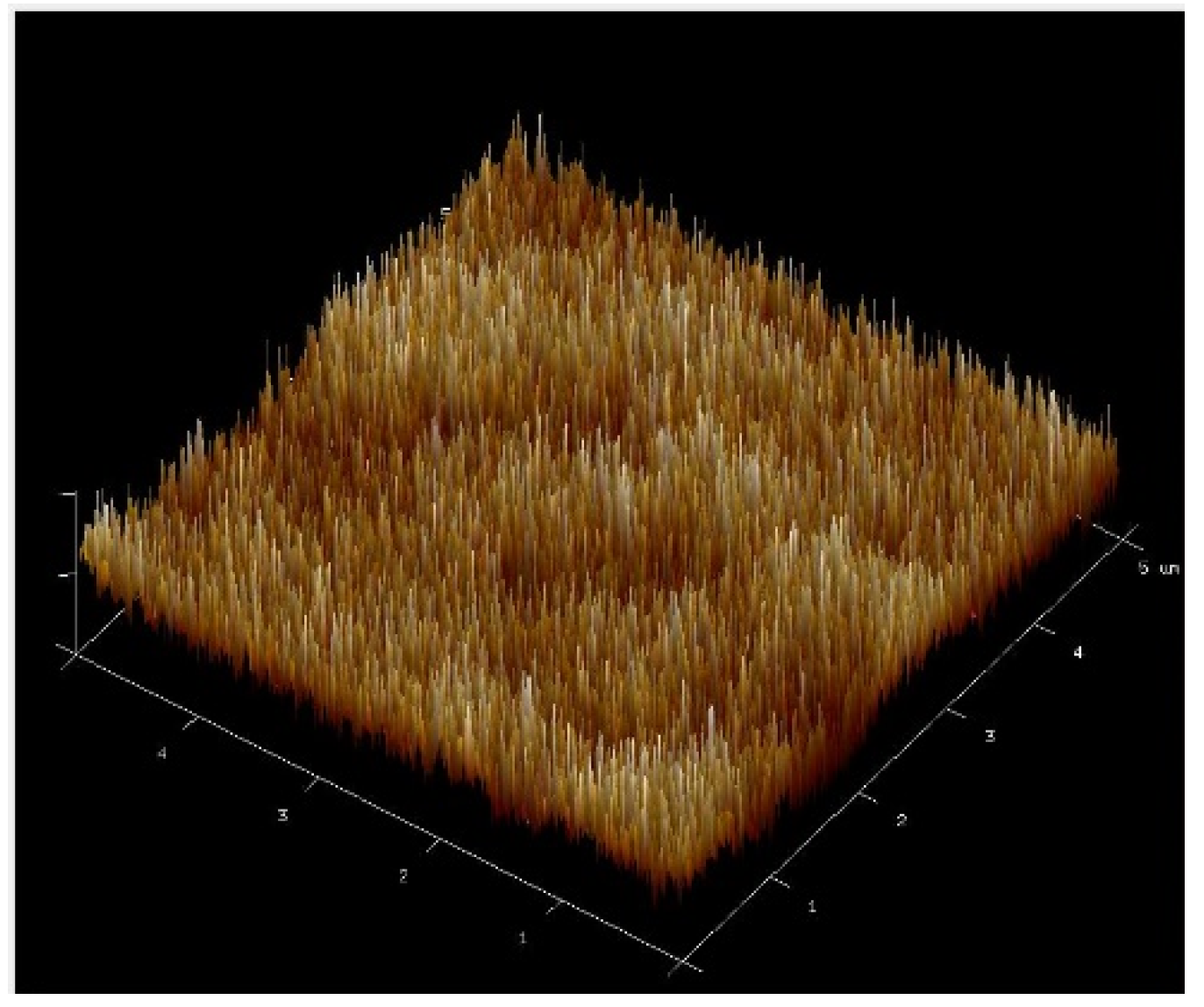
Figure 3.
The AFM images were captured over a scan area of using the NanoScope software of the ITO thin film after RTP at different annealing temperatures. In (a) AFM image of Sample B_3 annealed at 500°C, showing a value of 1.01 nm and an value of 1.34 nm. In (b), the AFM image of Sample B_2 annealed at 600°C, exhibiting a value of 1.22 nm and an value of 1.52 nm. The measured roughness parameters provide quantitative information about the surface characteristics, with both samples showing slightly increased roughness compared to the pre-annealing state. These observations demonstrate the impact of annealing temperature on the surface properties of the ITO thin film.
Figure 3.
The AFM images were captured over a scan area of using the NanoScope software of the ITO thin film after RTP at different annealing temperatures. In (a) AFM image of Sample B_3 annealed at 500°C, showing a value of 1.01 nm and an value of 1.34 nm. In (b), the AFM image of Sample B_2 annealed at 600°C, exhibiting a value of 1.22 nm and an value of 1.52 nm. The measured roughness parameters provide quantitative information about the surface characteristics, with both samples showing slightly increased roughness compared to the pre-annealing state. These observations demonstrate the impact of annealing temperature on the surface properties of the ITO thin film.
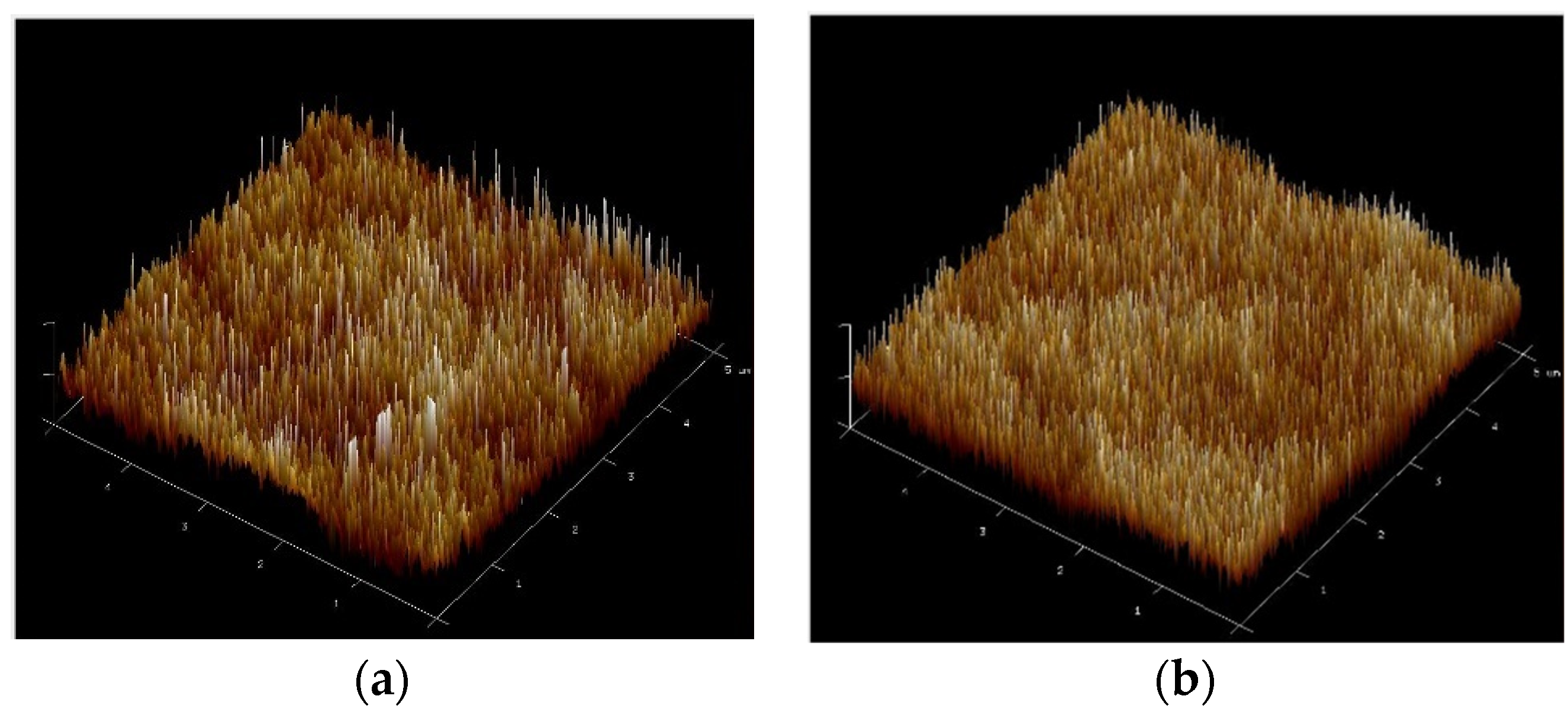
Figure 4.
The AFM images were captured over a scan area of using the NanoScope software of the ITO thin film after RTP at different annealing ramping rates. (a) AFM image of Sample C_2 annealed with a 50°C/s annealing ramping rate, showing a value of 0.888 nm and an value of 1.11 nm. (b) AFM image of Sample C_4 annealed with a 100°C/s annealing ramping rate, displaying a value of 1.04 nm and an value of 1.30 nm. The images depict the surface topography of the ITO thin film after undergoing RTP with varying annealing ramping rates. These results highlight the influence of the annealing ramping rate on the surface properties of the ITO thin film, indicating changes in surface topography as a result of the thermal treatment.
Figure 4.
The AFM images were captured over a scan area of using the NanoScope software of the ITO thin film after RTP at different annealing ramping rates. (a) AFM image of Sample C_2 annealed with a 50°C/s annealing ramping rate, showing a value of 0.888 nm and an value of 1.11 nm. (b) AFM image of Sample C_4 annealed with a 100°C/s annealing ramping rate, displaying a value of 1.04 nm and an value of 1.30 nm. The images depict the surface topography of the ITO thin film after undergoing RTP with varying annealing ramping rates. These results highlight the influence of the annealing ramping rate on the surface properties of the ITO thin film, indicating changes in surface topography as a result of the thermal treatment.
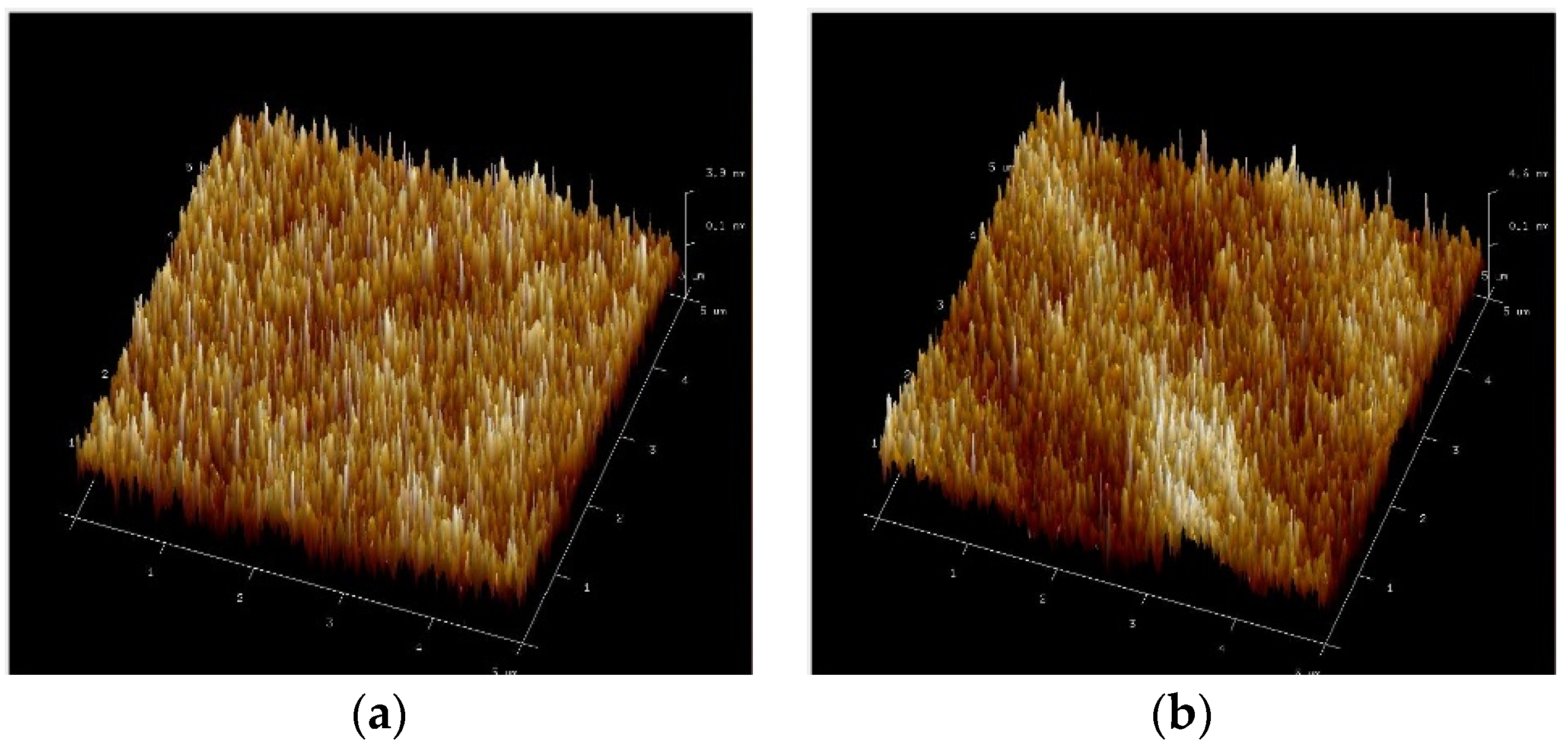
Figure 5.
The sheet resistance measurements of ITO thin film annealed in different gas medium (Ar, N2, and O2) at for 600 seconds. The x-axis represents the annealing gas medium (Ar, N2, and O2) and the y-axis represents the sheet resistance in ohms per square. The chart shows that the sheet resistance decreased from in the as-deposited (reference) sample to approximately after annealing. It is worth noting that annealing in Ar gas resulted in the lowest sheet resistance.
Figure 5.
The sheet resistance measurements of ITO thin film annealed in different gas medium (Ar, N2, and O2) at for 600 seconds. The x-axis represents the annealing gas medium (Ar, N2, and O2) and the y-axis represents the sheet resistance in ohms per square. The chart shows that the sheet resistance decreased from in the as-deposited (reference) sample to approximately after annealing. It is worth noting that annealing in Ar gas resulted in the lowest sheet resistance.
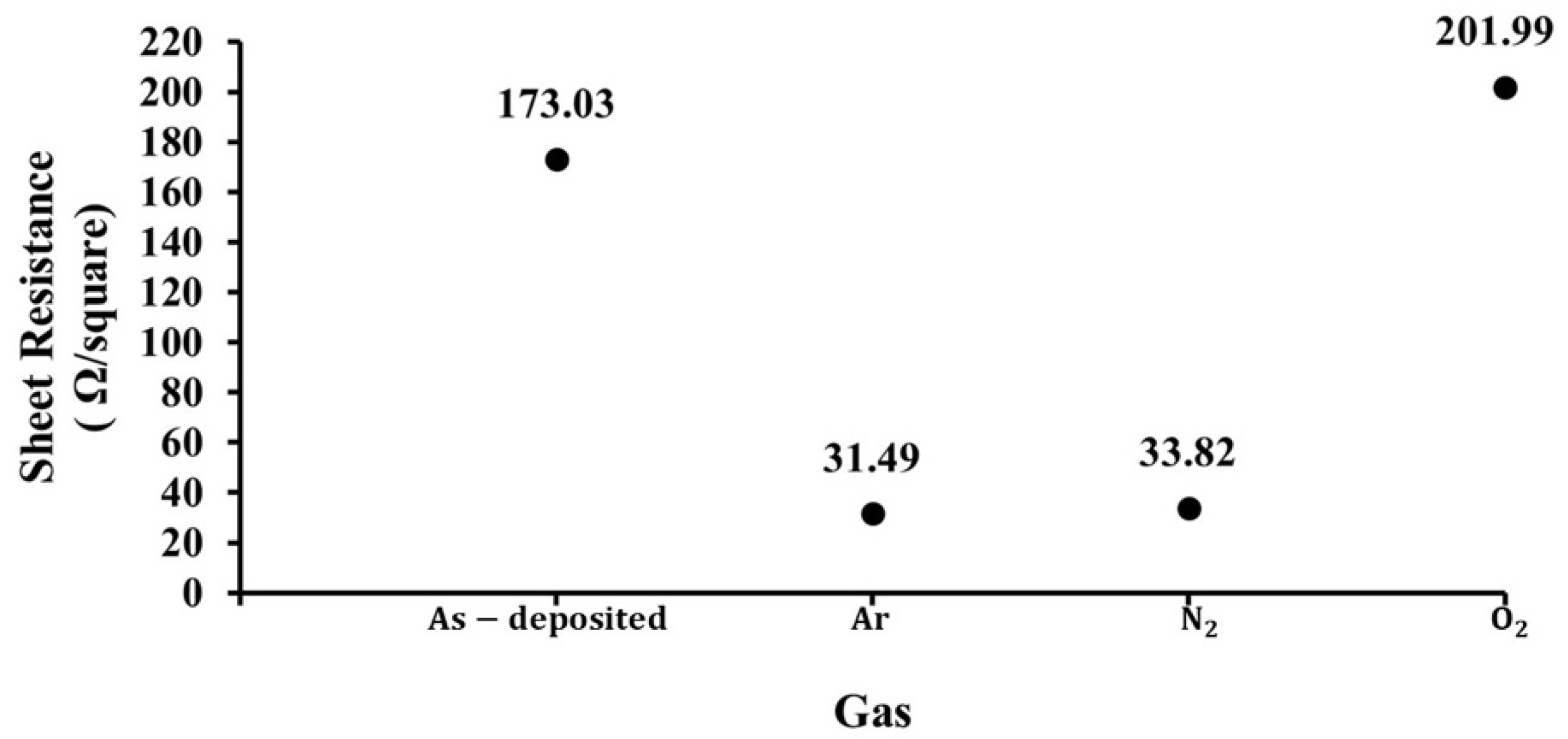
Figure 6.
The resistivity of ITO thin film annealed in different gas medium (Ar, N2, and O2) at for 600 seconds. The x-axis represents the annealing gas medium (Ar, N2, and O2), and the y-axis represents the resistivity in the ohm-centimeter. The chart illustrates the decrease in resistivity from 8.43 in the as-deposited (reference) sample to around 1.65 after annealing. It is worth noting that annealing in Ar gas exhibited the lowest resistivity.
Figure 6.
The resistivity of ITO thin film annealed in different gas medium (Ar, N2, and O2) at for 600 seconds. The x-axis represents the annealing gas medium (Ar, N2, and O2), and the y-axis represents the resistivity in the ohm-centimeter. The chart illustrates the decrease in resistivity from 8.43 in the as-deposited (reference) sample to around 1.65 after annealing. It is worth noting that annealing in Ar gas exhibited the lowest resistivity.
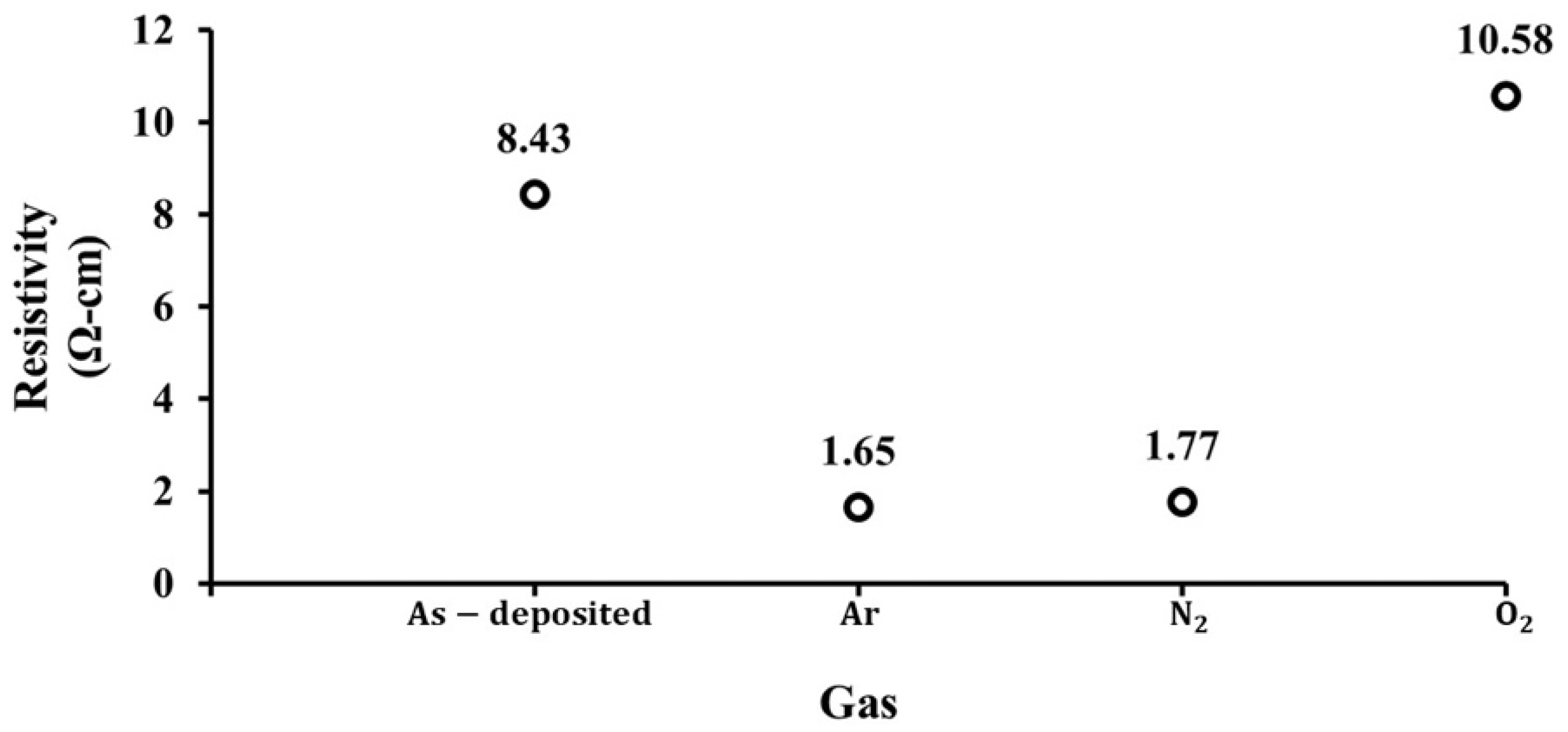
Figure 7.
Sheet resistance and resistivity of ITO thin film annealed in Ar gas at temperatures spanning 400 to 700. The x-axis represents the annealing temperatures in degrees Celsius, and the y-axis represents the sheet resistance in ohms per square on the right side and resistivity in ohm-centimeters on the left side. The chart demonstrates that as the temperature increased, the sheet resistance decreased from 147.41 at 300°C to at 600. The resistivity also decreased from 7.72 to 1.44 over the same temperature range.
Figure 7.
Sheet resistance and resistivity of ITO thin film annealed in Ar gas at temperatures spanning 400 to 700. The x-axis represents the annealing temperatures in degrees Celsius, and the y-axis represents the sheet resistance in ohms per square on the right side and resistivity in ohm-centimeters on the left side. The chart demonstrates that as the temperature increased, the sheet resistance decreased from 147.41 at 300°C to at 600. The resistivity also decreased from 7.72 to 1.44 over the same temperature range.
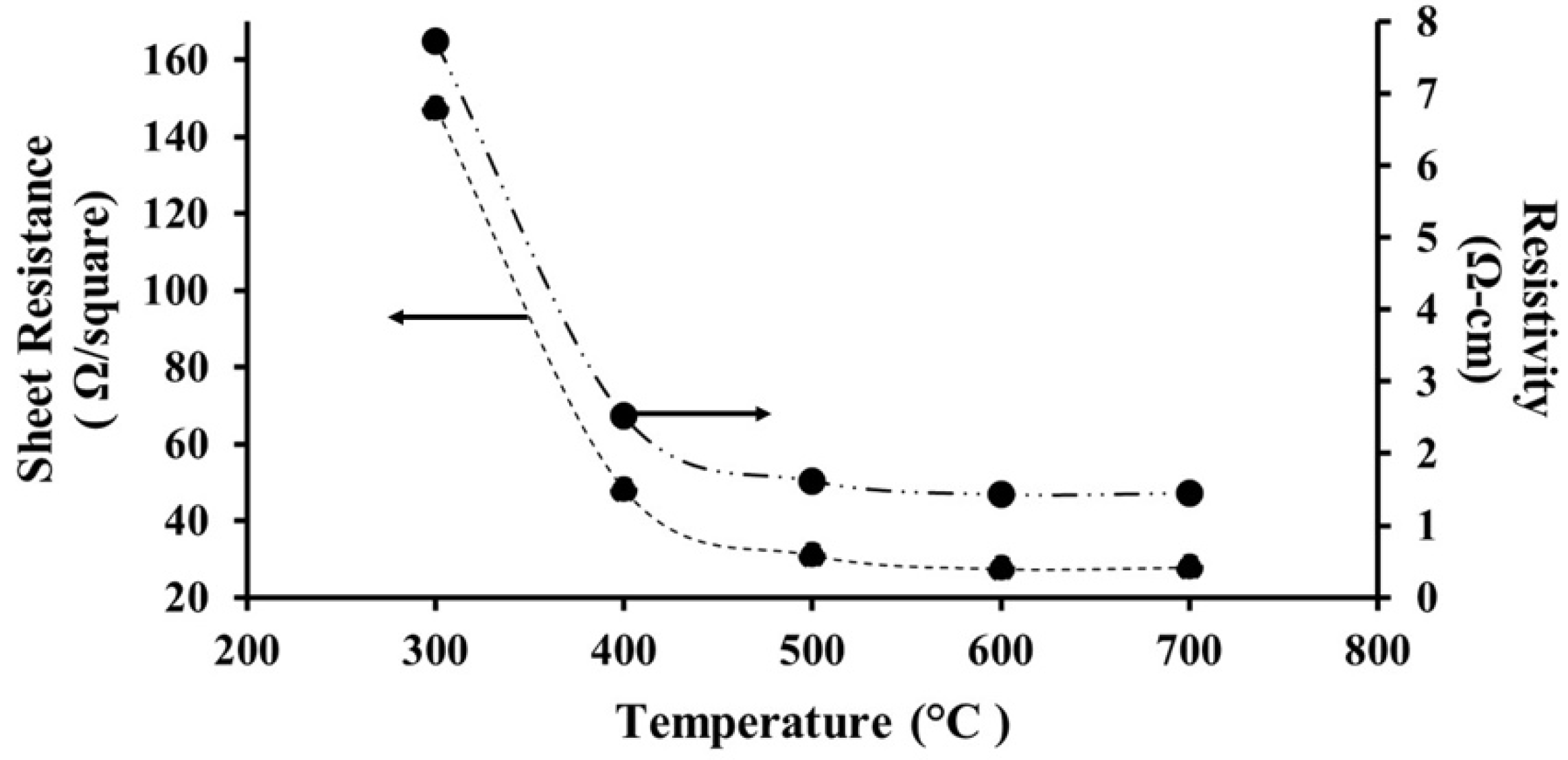
Figure 8.
Sheet resistance and resistivity of ITO thin film annealed in gas at 600°C with different annealing ramping rates. The x-axis represents the annealing ramping rates in degrees Celsius per second (), and the y-axis represents the sheet resistance in ohms per square on the right side and resistivity in ohm-centimeters on the left. The chart indicates that the sheet resistance decreased from 31.13 at an annealing ramping rate of 125 to 27.42 at an annealing ramping rate of 50. Similarly, the resistivity decreased from 1.63 to 1.43 .
Figure 8.
Sheet resistance and resistivity of ITO thin film annealed in gas at 600°C with different annealing ramping rates. The x-axis represents the annealing ramping rates in degrees Celsius per second (), and the y-axis represents the sheet resistance in ohms per square on the right side and resistivity in ohm-centimeters on the left. The chart indicates that the sheet resistance decreased from 31.13 at an annealing ramping rate of 125 to 27.42 at an annealing ramping rate of 50. Similarly, the resistivity decreased from 1.63 to 1.43 .
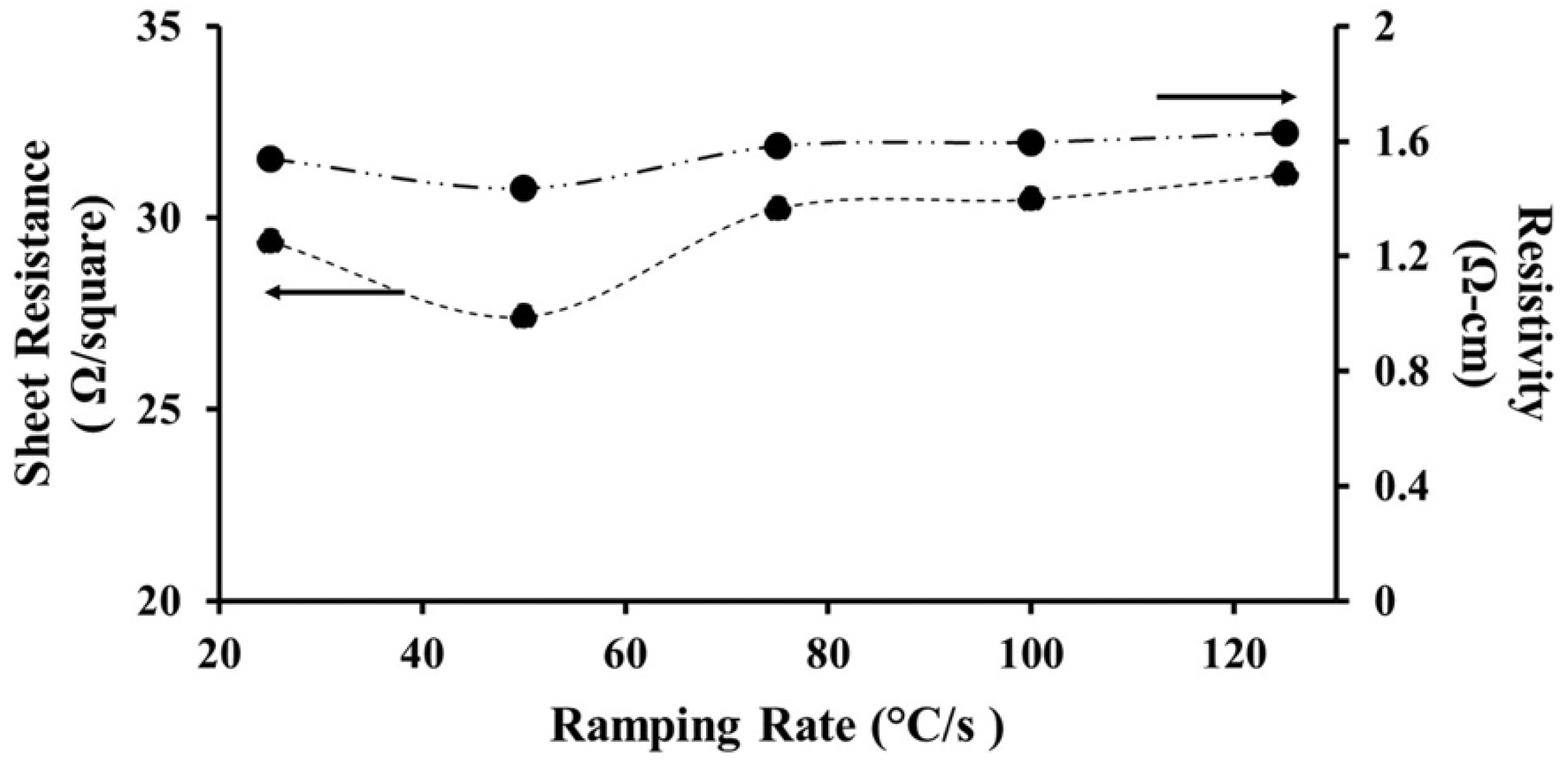
Figure 9.
The refractive index of ITO thin film annealed in different gas medium (Ar, N2, and O2) at for 600 seconds. The x-axis represents the annealing gas medium (Ar, N2, and O2) and the y-axis represents the refractive index. The chart shows that the refractive index decreased from in the as-deposited (reference) sample to approximately after annealing. Annealing in Ar gas resulted in the lowest refractive index, while annealing in O2 gas resulted in the highest refractive index.
Figure 9.
The refractive index of ITO thin film annealed in different gas medium (Ar, N2, and O2) at for 600 seconds. The x-axis represents the annealing gas medium (Ar, N2, and O2) and the y-axis represents the refractive index. The chart shows that the refractive index decreased from in the as-deposited (reference) sample to approximately after annealing. Annealing in Ar gas resulted in the lowest refractive index, while annealing in O2 gas resulted in the highest refractive index.
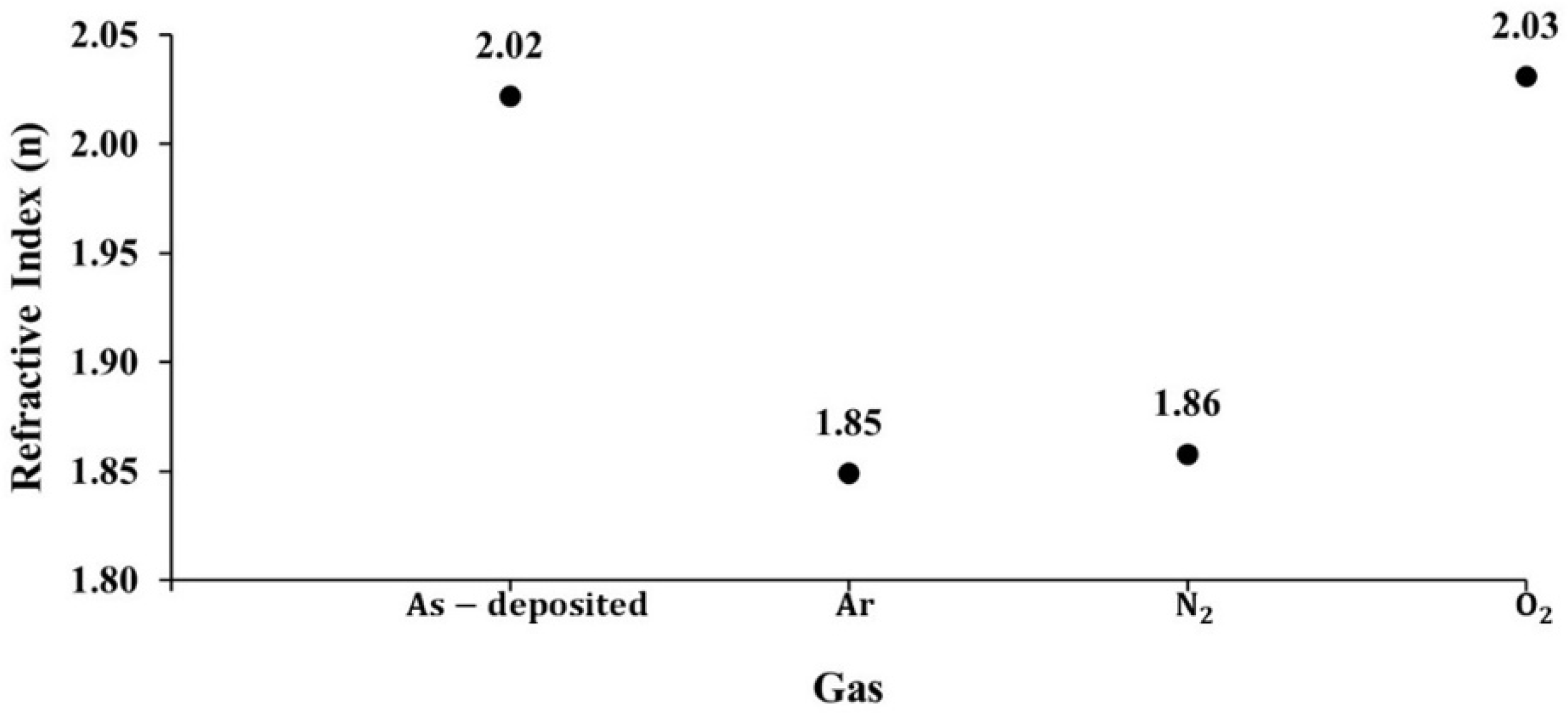
Figure 10.
The extinction coefficient of ITO thin film annealed in different gas medium (Ar, N2, and O2) at for 600 seconds. The x-axis represents the annealing gas medium (Ar, N2, and O2) and the y-axis represents the extinction coefficient. The chart shows that the extinction coefficient remains small for all samples, while O2 has the highest value of 0.023.
Figure 10.
The extinction coefficient of ITO thin film annealed in different gas medium (Ar, N2, and O2) at for 600 seconds. The x-axis represents the annealing gas medium (Ar, N2, and O2) and the y-axis represents the extinction coefficient. The chart shows that the extinction coefficient remains small for all samples, while O2 has the highest value of 0.023.
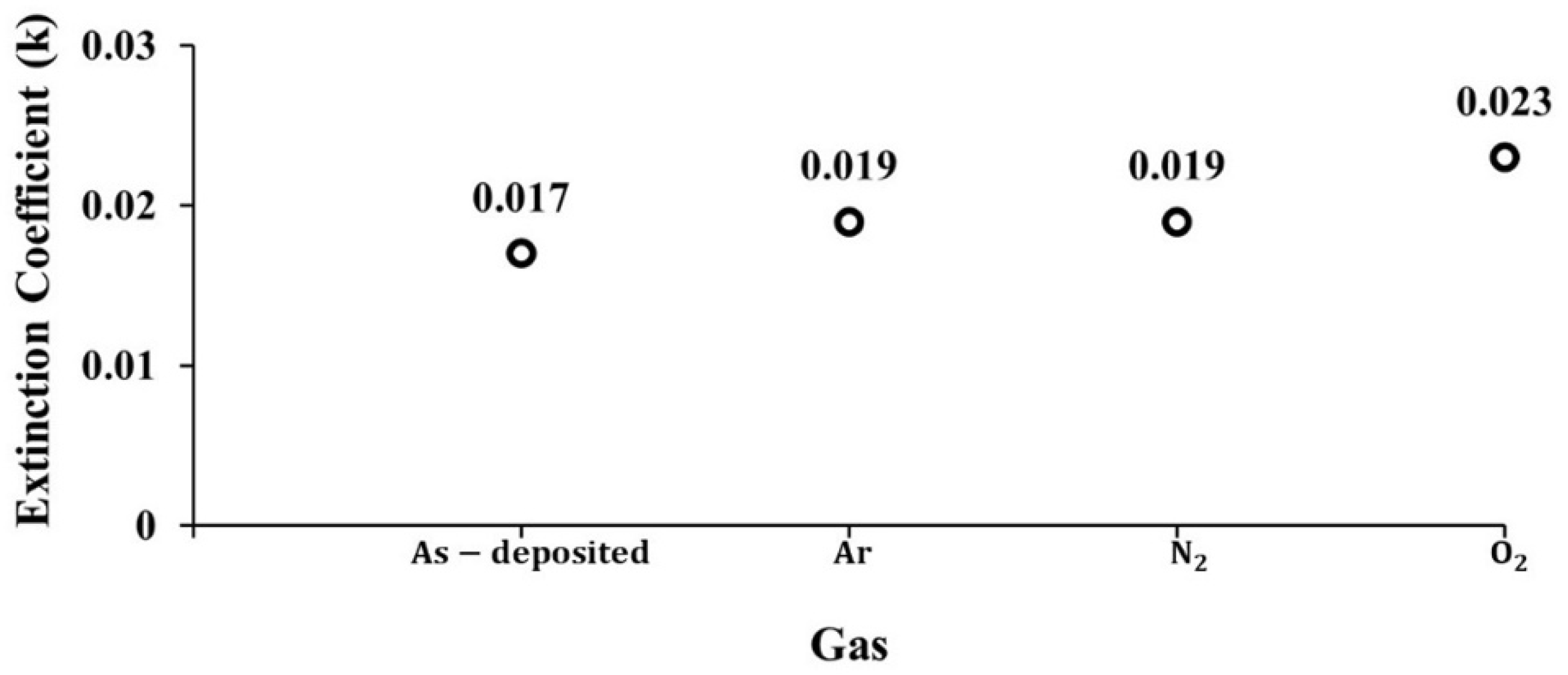
Figure 11.
The refractive index and extinction coefficient of ITO thin film annealed in Ar gas at temperatures spanning 300 to 700. The x-axis represents the annealing temperatures in degrees Celsius, and the y-axis represents the refractive index on the left side and the extinction coefficient on the right side. The chart demonstrates that as the temperature increased, the refractive index decreased from 1.94 at 300°C to 1.81 at 700. The extinction coefficient also decreased from 0.038 to 0.018 over 300°C and 400°C, respectively.
Figure 11.
The refractive index and extinction coefficient of ITO thin film annealed in Ar gas at temperatures spanning 300 to 700. The x-axis represents the annealing temperatures in degrees Celsius, and the y-axis represents the refractive index on the left side and the extinction coefficient on the right side. The chart demonstrates that as the temperature increased, the refractive index decreased from 1.94 at 300°C to 1.81 at 700. The extinction coefficient also decreased from 0.038 to 0.018 over 300°C and 400°C, respectively.
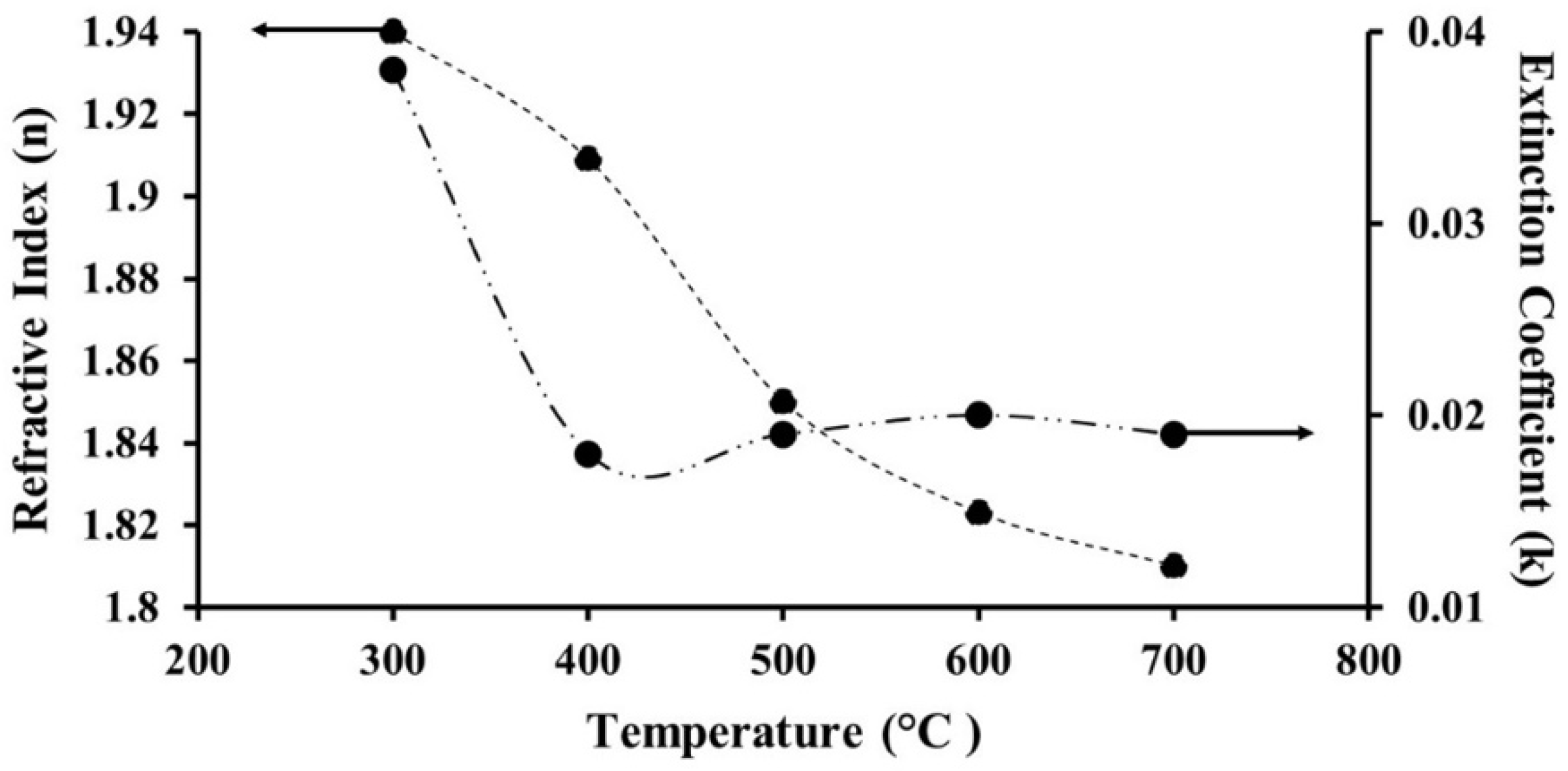
Figure 12.
The refractive index and extinction coefficient of ITO thin film annealed in Ar gas at 600°C with different annealing ramping rates. The x-axis represents the annealing ramping rates in degrees Celsius per second (), and the y-axis represents the refractive index on the left side and extinction coefficient on the right. The chart indicates that the refractive index starts to increase after 50°C/s, which has the lowest refractive index value of 1.817, which was found to be the optimal annealing ramping rate. The extinction coefficient also decreased from 0.025 to 0.011 over 25°C/s and 100°C/s respectively.
Figure 12.
The refractive index and extinction coefficient of ITO thin film annealed in Ar gas at 600°C with different annealing ramping rates. The x-axis represents the annealing ramping rates in degrees Celsius per second (), and the y-axis represents the refractive index on the left side and extinction coefficient on the right. The chart indicates that the refractive index starts to increase after 50°C/s, which has the lowest refractive index value of 1.817, which was found to be the optimal annealing ramping rate. The extinction coefficient also decreased from 0.025 to 0.011 over 25°C/s and 100°C/s respectively.
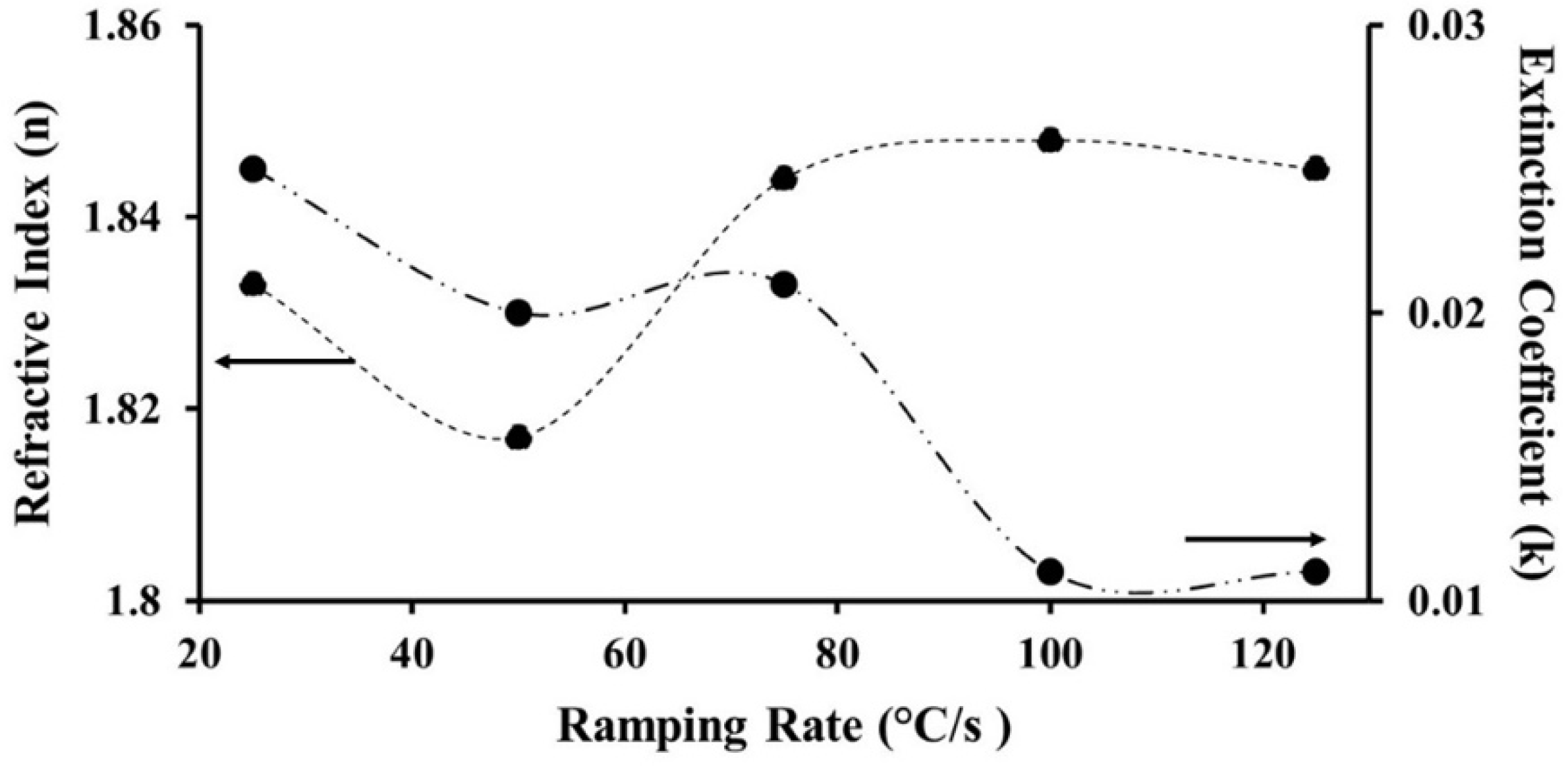
Table 1.
The table provides the annealing conditions for each tested sample. Samples in group (A) were used to select the annealing gas, while in group (B), the samples were used to identify the optimal annealing temperature. Finally, in group (C), samples were used to find the optimal annealing ramping rate.
Table 1.
The table provides the annealing conditions for each tested sample. Samples in group (A) were used to select the annealing gas, while in group (B), the samples were used to identify the optimal annealing temperature. Finally, in group (C), samples were used to find the optimal annealing ramping rate.
| Sample Group | Sample Number | Gas | Temperature |
|
|---|---|---|---|---|
| Reference | As deposited (0) | - | - | - |
| Group A | A_1 | Ar | 500 | 25 |
| A_2 | N2 | 500 | 25 | |
| A_3 | O2 | 500 | 25 | |
| Group B | B_1 | Ar | 300 | 25 |
| B_2 | Ar | 400 | 25 | |
| B_3 | Ar | 500 | 25 | |
| B_4 | Ar | 600 | 25 | |
| B_5 | Ar | 700 | 25 | |
| Group C | C_1 | Ar | 600 | 25 |
| C_2 | Ar | 600 | 50 | |
| C_3 | Ar | 600 | 75 | |
| C_4 | Ar | 600 | 100 | |
| C_5 | Ar | 600 | 125 |
Disclaimer/Publisher’s Note: The statements, opinions and data contained in all publications are solely those of the individual author(s) and contributor(s) and not of MDPI and/or the editor(s). MDPI and/or the editor(s) disclaim responsibility for any injury to people or property resulting from any ideas, methods, instructions or products referred to in the content. |
© 2024 by the authors. Licensee MDPI, Basel, Switzerland. This article is an open access article distributed under the terms and conditions of the Creative Commons Attribution (CC BY) license (https://creativecommons.org/licenses/by/4.0/).
Copyright: This open access article is published under a Creative Commons CC BY 4.0 license, which permit the free download, distribution, and reuse, provided that the author and preprint are cited in any reuse.
Alerts
MDPI Initiatives
Important Links
© 2024 MDPI (Basel, Switzerland) unless otherwise stated






